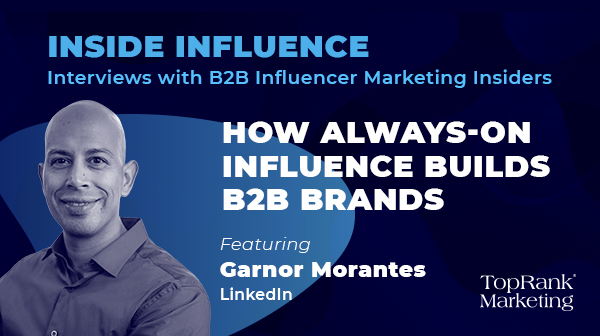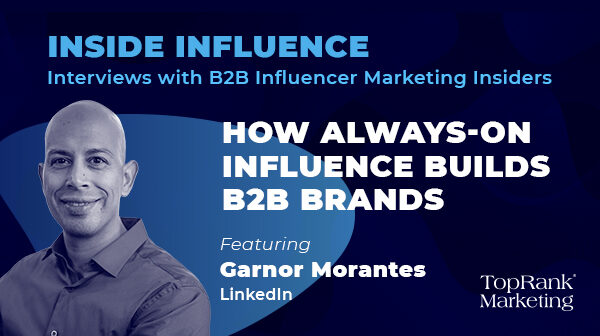
Welcome to the second episode of Inside B2B Influence: Interviews with B2B Influencer Marketing Insiders. Each week we feature an interview with a B2B marketing insider on all things influence and a deeper dive into the insights found in the 2020 State of B2B Influencer Marketing Report.
This week, we’re talking to Garnor Morantes, Group Marketing Manager at LinkedIn. Our team at TopRank Marketing has been fortunate to work with Garnor on an award-winning, ongoing influencer marketing program for LinkedIn over several years and his leadership has been instrumental in its success.
Our conversation touches on:
- What Always-On influencer marketing is and why its valuable for B2B brands
- The challenges faced by campaign-focused influencer marketing efforts
- Advice for B2B marketers considering influencer marketing
- How LinkedIn Marketing and Sales Solutions (clients) has developed an influencer community with an Always-On approach
- Key statistics from the 2020 State of B2B Influencer Marketing Report
- How LinkedIn works with influencers to improve customer and prospect experience
- Whether marketers should pause or proceed with influencer marketing during the pandemic
- Who some of the rising star B2B marketing and sales influencers we should be paying attention to
- Predictions on the future of influencer marketing for B2B brands
Check out the full interview podcast here:
The work that we’re doing with influencers is not centered around campaigns, it’s centered around relationships.
How would you explain an Always-On approach to Influencer Marketing to someone who is not familiar?
Garnor: For us as we think about Always-On as a strategy, the biggest thing that comes to mind is that the work that we’re doing with influencers is not centered around campaigns, it’s centered around relationships. What I mean by that is, who do we want to be working with, who do we want to tell our story, who do we want to engage with.
It’s about building that relationship and finding people that are going to get mutual benefit out of this relationship and as a result we can have that type of engagement that isn’t just centered around different points in time like in a campaign based strategy.
The other thing I think about when it’s Always-On is really, are you activating this program through some channels that are always on? For us it’s our blog and our social channels and those are 24/7. I think that’s another way to think of an Always-On type of strategy.
At LinkedIn Marketing and Sales you’ve take more of an Always-On approach to influencer marketing with some great results in terms of reach and engagement. Can you share a little bit about your objectives and approach?
Garnor: Our objectives as we think about the influencer program is that it works really well in concert with our other programs, our other communities: customer advocates and even industry analysts is that we want to leverage and work with the influencer program in way that it is able to take the messages we want to deliver as a brand or business unit for Sales Solutions and Marketing Solutions, and empower those influencers to tell that story as well.
Our objective (with influencers) is that they know what our story is, that they are familiar with it and can lend input into it as well.
As I mentioned earlier, they have their own story to tell, their own brand, and their own narrative. So I feel that we are finding influencers that are already aligned with that message and that story. Our objective is that they know what our story is, that they are familiar with it and can lend input into it as well. They are the experts in many instances. They’re the feet on the ground who are talking to the marketers on a daily basis, talking to the sellers. So we want that feedback, that input into it.
The objective is equally gathering that input, getting better at telling our story and developing our products and services, while at the same time empowering a set of advocates or people out there that have large followings, or developing followings or are just experts in their field to tell that story as well.
That’s really at a high level the objectives we are trying to meet as we develop these programs. And we do that by keeping an eye out for the types of content that influencers might be creating that supports the message we’re telling. At the same time on occasion, creating some new campaigns in which we can arm these influencers with more information, with some assets that tell the story that we want to put out there – create some new content around that and have them be a key part of the delivery and the content creation.
What do you think are some of the top challenges working with B2B influencers today?
You put your message and your brand in the hands of someone else, what happens if that person says some things that are not in alignment with your brand?
Garnor: I go back to what’s going on in society and really that backdrop that we all heavily need to consider with everything we’re doing these days. There is that risk: you put your message and your brand in the hands of someone else, what happens if that person says some things that are not in alignment with your brand?
There’s a bit of that risk, there’s a bit of that challenge. For us, we have really placed a ton of emphasis on developing the trust and relationships with influencers – we feel pretty good about it, about where we stand, about the messages they’re going to deliver and what they’re going to say. That’s a risk.
Another challenge is one that you also mentioned earlier, is how do you find the right influencers? There’s so many people out there purporting to be experts. How do you find the right ones? We already talked about some of the ways to do that, being a more active part of the conversation.
The number of B2B brands considering influencer marketing for the first time or elevating their efforts has actually increased in the past 6 months. At the same time, our research shows that 60% of marketers do not feel they have the right skills in house or capability to execute. What advice can you share with marketers considering an influencer marketing program?
Garnor: I think the advice that I would give is take a moment and step back and not think of it as an influencer program. Think of it more as what is helpful for your buyers? What is important for your buyers and what they could benefit from?
Start thinking about who the audience truly is and as a result, who might be able to speak to them better than you can?
When you stop and take a look at that, then you start thinking about who that audience truly is and as a result, who might be able to speak to them better than you can?
For example, if you think about our business lines, the ones that I support, we’re talking about marketers and sellers. Yes I work in marketing, but I don’t have the necessary skill sets that I think a lot of these marketers are asking for. So then you start to take a look at what are they asking for? What are those conversations and who is a part of that conversation and can we have a relationship with them?
I think that’s the place to start. It removes some of the overwhelming nature of what setting up an influencer program can be. If you just think about who are the sales leaders and people who are experts in sales I should be talking to? Because that’s my end goal, to talk to sellers.
Let me start there, let me build a relationship with them. Let me see what they need, or what they have to offer and what I can offer them. That can do some of the upfront work of identification of influencers and also what ultimate output, methodology and process are going to work best because it happens from those discussions and relationships. I think that’s the advice I would give.
Check out the full video interview with Garnor here:
To connect on all things B2B marketing with Garnor, be sure to follow him on LinkedIn.
Next up on Inside B2B Influence we will be talking with with Ursula Ringham, Head of Global Influencer Marketing at SAP about the behind the scenes role of influencer marketing operations from strategy to software.
Be sure to check out our previous Inside B2B Influence interview with Rani Mani, from Adobe.



